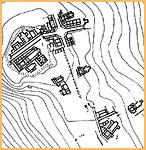|
Justiniana Prima, the city of Justinian
Built by Justinian to honor his own birthplace,
Justiniana Prima was a  fortified
city of modest size soon to be made the seat of the archibishop
of Illyricum. Originally, it consisted of an acropolis and
an upper' city, the former occupied by an episcopal cathedral
and palace. Although, the upper' city features the customary
colonnaded
cardo and decumanus, their
intersection marked by a large circular plaza, it retreats
from traditional urban planning. A few urban mansions, military
headquarters, and several large churches occupied most of
the enclosed area, leaving little space for housing and recreational
facilities. Justiniana Prima was more of a monumental complex
serving an ecclesiastical, military and civil administration,
rather than a proper city. Its predominantly rural population
lived mostly outside the walls where the only public bathhouse
is to be found. In the late sixth century, under
Justin II (565-578),
the lower' city was fortified in order to accomodate an increasing
number of people seeking protection from alien invaders. At
the same time, traditional urbanism declined as private individuals
set up their homes and workshops on every inch of available
space. Shacks of wood or stone built near the fortifications,
around churches, inside atria and
porticoes, housed
bakers, silversmiths, blacksmiths, potters, carpenters, and
furriers. Existing buildings were adapted to new purposes.
Walls were erected inside the public bathhouse in order to
create additional living quarters. A kiln was installed in
the episcopal palace. Before the city was abandoned, in the
seventh century, its urban nature had given way to a marked
rural character. fortified
city of modest size soon to be made the seat of the archibishop
of Illyricum. Originally, it consisted of an acropolis and
an upper' city, the former occupied by an episcopal cathedral
and palace. Although, the upper' city features the customary
colonnaded
cardo and decumanus, their
intersection marked by a large circular plaza, it retreats
from traditional urban planning. A few urban mansions, military
headquarters, and several large churches occupied most of
the enclosed area, leaving little space for housing and recreational
facilities. Justiniana Prima was more of a monumental complex
serving an ecclesiastical, military and civil administration,
rather than a proper city. Its predominantly rural population
lived mostly outside the walls where the only public bathhouse
is to be found. In the late sixth century, under
Justin II (565-578),
the lower' city was fortified in order to accomodate an increasing
number of people seeking protection from alien invaders. At
the same time, traditional urbanism declined as private individuals
set up their homes and workshops on every inch of available
space. Shacks of wood or stone built near the fortifications,
around churches, inside atria and
porticoes, housed
bakers, silversmiths, blacksmiths, potters, carpenters, and
furriers. Existing buildings were adapted to new purposes.
Walls were erected inside the public bathhouse in order to
create additional living quarters. A kiln was installed in
the episcopal palace. Before the city was abandoned, in the
seventh century, its urban nature had given way to a marked
rural character.
|